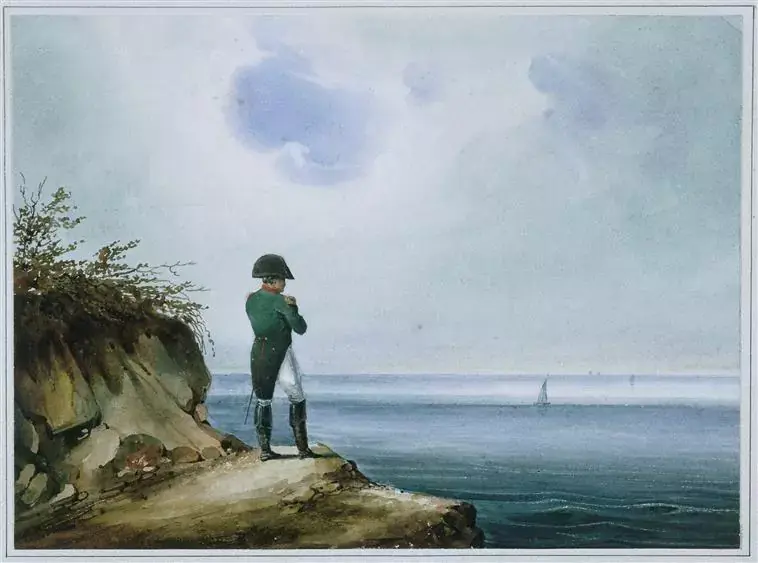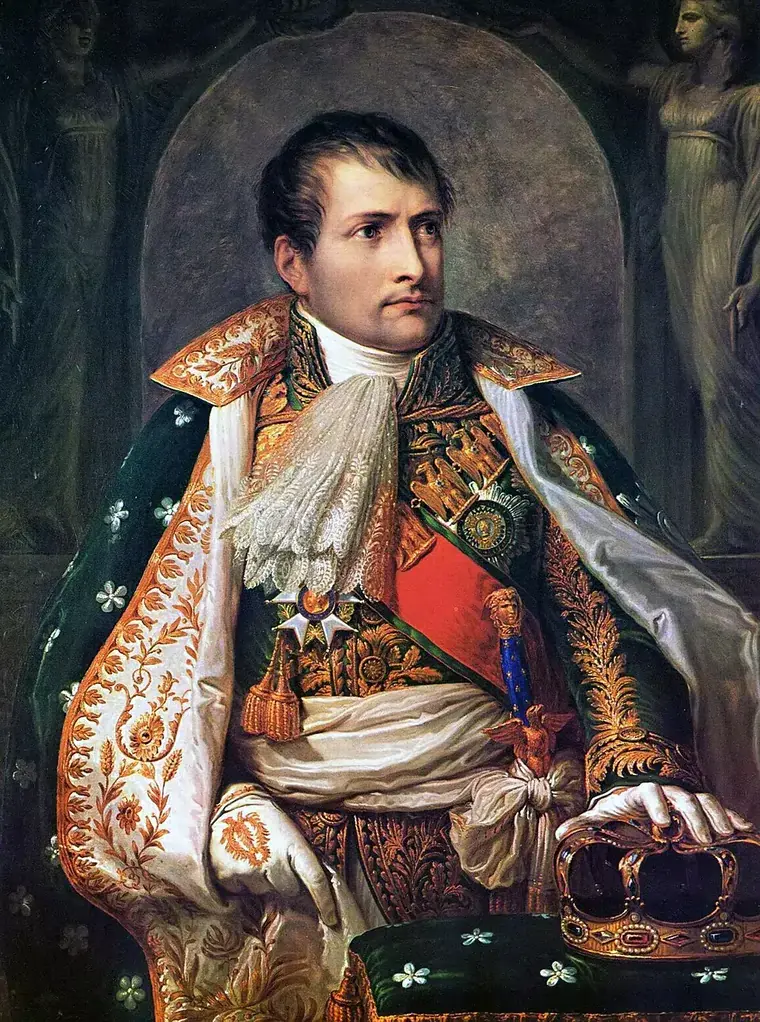Napoleon in Exile: Life on Elba and Saint Helena
- Davit Grigoryan
- Aug 27
- 9 min read
Updated: Sep 2
Imagine standing on the deck of a ship, watching the coastline of France vanish forever. For Napoleon Bonaparte, the man who once commanded an empire that stretched across Europe, this was the stark reality of his fall.
His journey into exile is a tale of two islands: Elba and Saint Helena. On Elba, he arrived still bearing the title of Emperor, albeit of a tiny Mediterranean domain he would energetically, if briefly, rule.

But his final exile was of an entirely different nature. Saint Helena was a remote British-held rock in the South Atlantic, a place of unrelenting wind and isolation. Here, the once-formidable leader lived out his last years under constant watch, a prized prisoner.
This dramatic contrast—from the master of continents to a man confined to a small, damp house under strict surveillance—is what makes his final chapter so compelling. Exploring how these years of captivity defined his end and ultimately forged his enduring legacy is a story of its own.
Collapse and First Exile – Napoleon on Elba (1814–1815)
The year 1814 marked a stunning reversal of fortune. After a series of disastrous military campaigns, Paris fell to the Coalition forces. With his marshals refusing to fight on, Napoleon had no choice but to abdicate.
The resulting Treaty of Fontainebleau was a curious document. It stripped him of his imperial throne over France but granted him sovereignty over the small Mediterranean island of Elba, a domain of just 12,000 inhabitants. This was not to be a brutal imprisonment but a sovereign exile, a bizarre arrangement that allowed him to retain his title of Emperor.

Arriving on Elba in May 1814, Napoleon did not succumb to despair. With characteristic energy, he immediately set about governing his miniature kingdom as if it were a major European power.
He embarked on a whirlwind of reforms, modernizing the island's infrastructure, improving its roads, and revitalizing its mining and agricultural output. He even established an efficient little navy and a well-drilled army, albeit one of just over a thousand men.
His court, though small, maintained a semblance of imperial grandeur. For ten months, the man who had redrawn the map of Europe focused his immense administrative talents on this speck of land, proving that he could not simply stop being a ruler.
Yet, this period of Napoleon on Elba was always a tense interlude, both for him and for the great powers watching from afar. From his island, he followed the political unrest brewing in France and the disagreements among the victors at the Congress of Vienna. The world that had cast him out seemed unstable.
This simmering discontent, combined with his own insatiable ambition, made his peaceful retirement an impossibility. The confines of the island became a cage for a man of his spirit.
In February 1815, in a daring and almost theatrical escape, he slipped past his British guards, boarded a ship, and set sail for France. His audacious return would shatter the peace of Europe and begin the final, dramatic chapter of his career, known as the Hundred Days.
Return and Defeat – From Elba to Waterloo, Leading to Saint Helena
The escape from Elba in February 1815 stands as one of history’s most breathtaking political gambits. With a handful of loyalists and barely a shot fired, Napoleon sailed toward France, directly challenging the Bourbon restoration.
His march to Paris became a triumphant procession; the soldiers sent to arrest him instead flocked to his banner, unable to resist the pull of the legendary emperor. King Louis XVIII fled, and within weeks, Napoleon was once again installed in the Tuileries Palace—not as a conqueror returning from abroad, but as a sovereign reclaiming his throne.

This audacious return sent shockwaves through the courts of Europe, shattering the fragile peace and forcing the allied powers to hastily reassemble their armies.
This period, famously known as the Hundred Days, was a frantic race against time. Napoleon understood that his legitimacy rested entirely on a swift military and political victory. He presented a new, more liberal constitution in an attempt to win popular support and worked tirelessly to mobilize the French nation for war.
But diplomacy was impossible; the allies were united in their resolve to crush him permanently. The stage was set for a final, decisive confrontation.
That clash came at the Battle of Waterloo on June 18, 1815. Despite a masterful display of tactical command for much of the day, the arrival of the Prussian army under Gebhard von Blücher and the dogged resistance of Wellington’s forces culminated in a devastating defeat for the French. The myth of his invincibility was finally broken on that muddy Belgian field.
Retreating to Paris, Napoleon found his political support had evaporated. A second abdication was inevitable. His initial hope was to slip away to the United States, a new republic where he might find asylum and perhaps a quiet life.
He even reached the port of Rochefort, but the British Royal Navy had imposed a strict blockade, making escape impossible. Faced with few options, he made the fateful decision to place himself under the protection of Captain Frederick Maitland of HMS Bellerophon, famously stating, “I come to claim the protection of your laws and your Prince.” He perhaps hoped for a comfortable exile in the English countryside.
However, the British government, wary of his ability to stir trouble from anywhere in Europe, had already decided his fate. Declaring him a prisoner of war and a “General Bonaparte”—stripping him of his imperial title—they decreed he would be exiled to the remote, heavily garrisoned island of Saint Helena. This exile was designed to be permanent, a life sentence intended to ensure the great disturber of European peace could never return.
Life on Saint Helena – The Briars, Longwood House, and Surveillance
The sheer, forbidding cliffs of Saint Helena rising from the South Atlantic Ocean in October 1815 must have presented a profoundly disheartening sight. After two months at sea aboard HMS Northumberland, Napoleon’s new prison was a volcanic rock thousands of miles from any major continent, chosen by the British precisely for its inaccessibility.
His initial accommodation was at The Briars, a pleasant estate where he stayed for two months as Longwood House was prepared. This brief interlude was almost agreeable, but it was a fleeting glimpse of comfort.

His permanent residence, Longwood House, was a former agricultural lodge situated on a windswept, damp plateau often shrouded in mist.
A monotonous and oppressive routine dominated life at Longwood, contrasting sharply with the glittering courts of Europe. The house itself was damp, poorly constructed, and infamously unhealthy, with rooms that were either stiflingly hot or bitterly cold and plagued by rats.
The real torment, however, was not the rustic conditions but the relentless and often petty surveillance orchestrated by the island’s governor, Sir Hudson Lowe. A meticulous and paranoid man, Lowe enforced a rigid set of regulations designed to crush any hope of escape or continued influence.
Napoleon’s correspondence was censored, his movements were restricted, and he was required to be visible to British soldiers at least twice daily. This constant observation, a deliberate strategy to humble the former emperor, became a source of immense psychological strain and frequent, bitter clashes between the two men.
In this claustrophobic environment, Napoleon was forced to construct a new, shrunken version of his former life. His days followed a predictable pattern: reading voraciously from the library he had brought, dictating his memoirs to the loyal companions who shared his exile, and engaging in endless games of cards or chess.
He took walks in the garden his staff had built, though these were always within sight of sentries. British officers always shadowed his conversations, even when he received visitors.
This crushing isolation and lack of intellectual stimulation weighed heavily on him. The vibrant, energetic commander was gradually replaced by a man sinking into the lethargy of boredom and ill health—a prisoner not just of the British Empire, but of his own monumental past and a remote, unforgiving island.
Memoirs and Solitude – The Memorial of Saint Helena
Confronted with interminable isolation and a future stripped of all agency, Napoleon embarked on his final and perhaps most successful campaign: the battle for his legacy.
Realizing that his physical empire was lost, he set out to construct an intellectual one, one that would shape how history would remember him. His weapon of choice was his voice, and his ammunition was memory.
Day after day, in the damp confines of Longwood House, he tirelessly dictated his thoughts, reflections, and justifications to the small band of loyalists who had chosen to share his exile. This project became his primary occupation, a mental defiance against the physical constraints imposed upon him.

Among his companions, the most significant for posterity was Emmanuel de Las Cases, a minor nobleman who served as his dedicated scribe.
For hours on end, Las Cases would scribble notes as Napoleon held forth, reconstructing his battles, his political philosophy, and his version of events with vivid detail and often brilliant insight. These sessions were not mere historical record-keeping; they were a calculated effort to frame his life’s work.
He portrayed himself not as a warmonger but as a son of the Revolution, a rational ruler bringing order to a chaotic continent, and a man of peace constantly thwarted by the intransigence of old monarchical Europe. He spoke of his reforms, the Civil Code, and his vision for a united Europe, consciously building the image of a visionary misunderstood and betrayed.
When Las Cases was expelled from the island by the suspicious Hudson Lowe in 1816, he smuggled out his copious notes. These would form the basis of The Memorial of Saint Helena, a literary bombshell published in 1823, two years after Napoleon’s death.
The book became an instant and phenomenal bestseller across Europe. It offered the public an intimate, sympathetic, and compelling portrait of the fallen emperor, transforming him from a defeated tyrant into a tragic, romantic hero.
This powerful narrative, forged in the solitude of his exile, effectively cemented the "Napoleonic legend." It washed away the memory of the countless lives lost in his wars and replaced it with a potent myth of glory, genius, and martyrdom that would profoundly influence 19th-century politics and ensure his name would echo far louder in death than many of his vanquishers would in life.
Final Days, Death, and Legacy Back in France
The final years on Saint Helena were a slow and agonizing surrender to physical decline. From around 1819 onward, Napoleon's health deteriorated markedly. He suffered from a constellation of debilitating symptoms: severe abdominal pain, nausea, and profound weakness that left him increasingly bedridden.
The damp, unhealthy climate of Longwood House was widely blamed by his companions, who pleaded in vain with Governor Lowe to allow a move to a more suitable residence. The attending British physicians diagnosed a "hepatic" condition, essentially a disease of the liver, but they were largely powerless to help.

Modern analysis, including studies of arsenic levels in his hair and the detailed description of his symptoms, strongly suggests the true culprit was advanced stomach cancer, the same illness that had claimed his father. His body was slowly failing him, mirroring the captivity that had broken his spirit.
He died on May 5, 1821, after weeks of immense suffering. His final words, whispered in delirium, were a fitting summary of his life: "France...army...head of the army...Josephine..."
His passing did not end the British vigilance; he was buried four days later in a shaded valley on the island, in a tomb bearing only the name "Napoleon." There he remained for nearly two decades, a silent figure in a remote landscape.
Yet, his story was far from over. In 1840, in a calculated political move to bolster the prestige of the July Monarchy, King Louis-Philippe orchestrated the dramatic repatriation of Napoleon’s remains. The event, known as the retour des cendres (return of the ashes), was a national spectacle. His body was received with immense ceremony and finally interred in a magnificent porphyry sarcophagus beneath the dome of Les Invalides in Paris, a final resting place fit for an emperor.
This journey from a lonely grave on Saint Helena to the grandeur of Les Invalides perfectly encapsulates his complex legacy. The years of exile were instrumental in transforming the historical figure into an enduring legend.
In death, the contentious emperor, the authoritarian ruler, and the architect of costly wars was gradually overshadowed by the romantic image of the Promethean hero, chained to a rock by his petty enemies. His final exile provided the poignant, tragic coda that his story needed to achieve mythic status.
It allowed for a rehabilitation of his image, framing him not just as a conqueror but as a great administrator and a visionary whose ideas on law, government, and society would outlive him and continue to shape modern Europe, securing his place as one of history's most fascinating and influential figures.



Comments